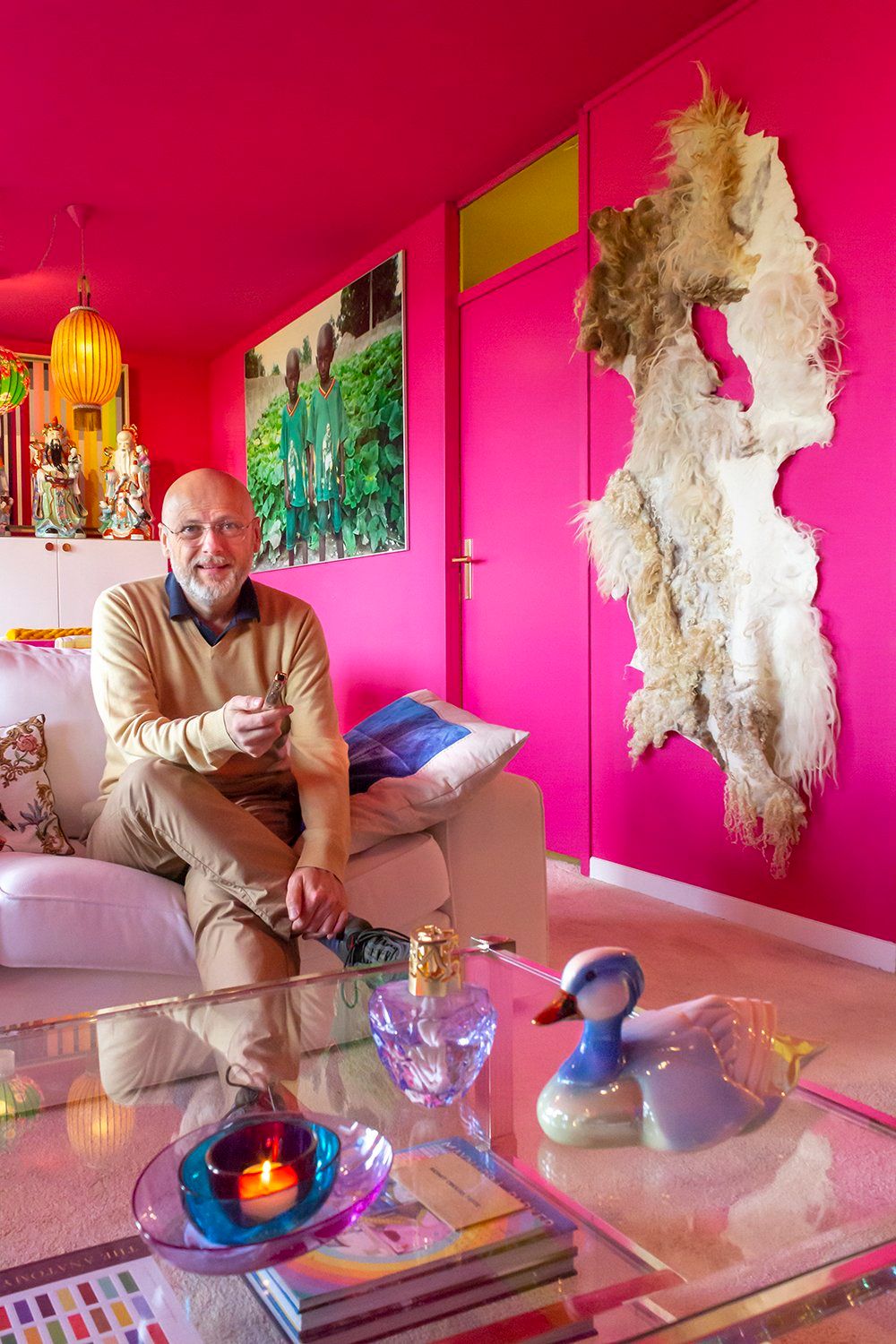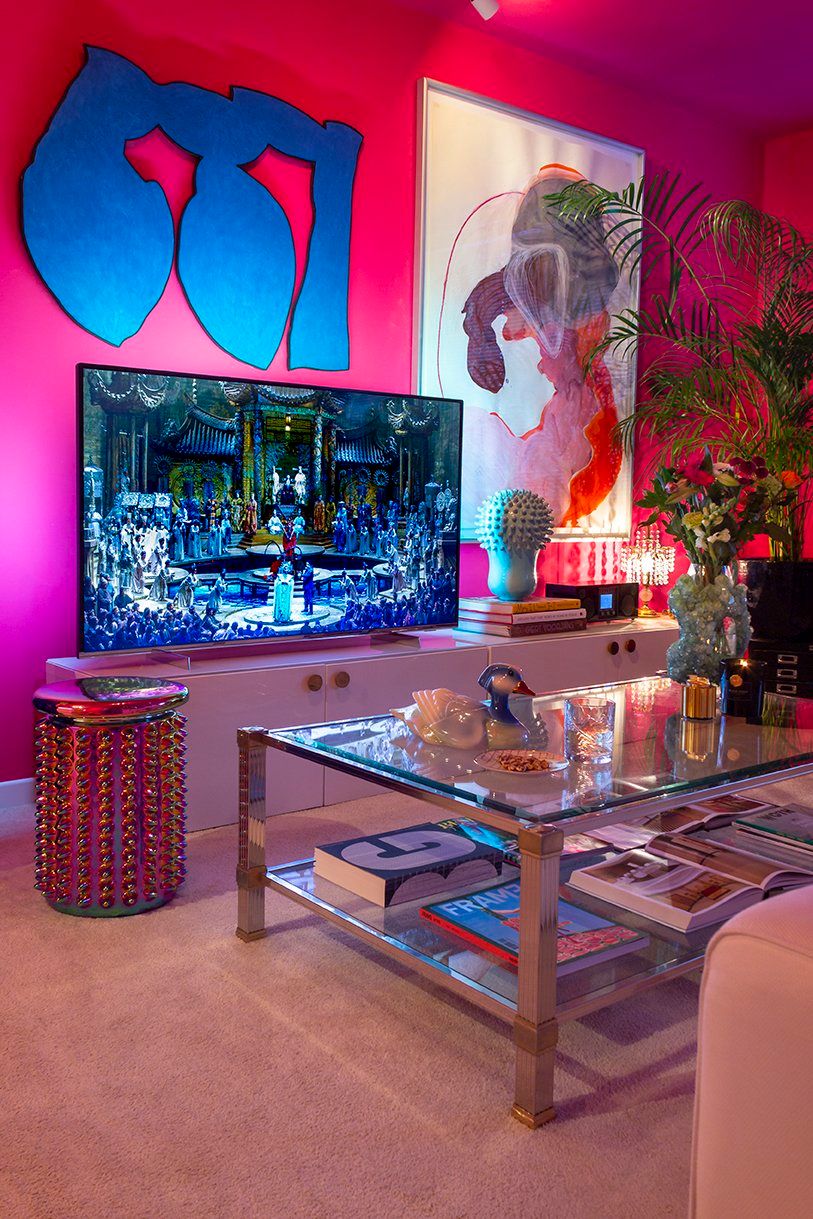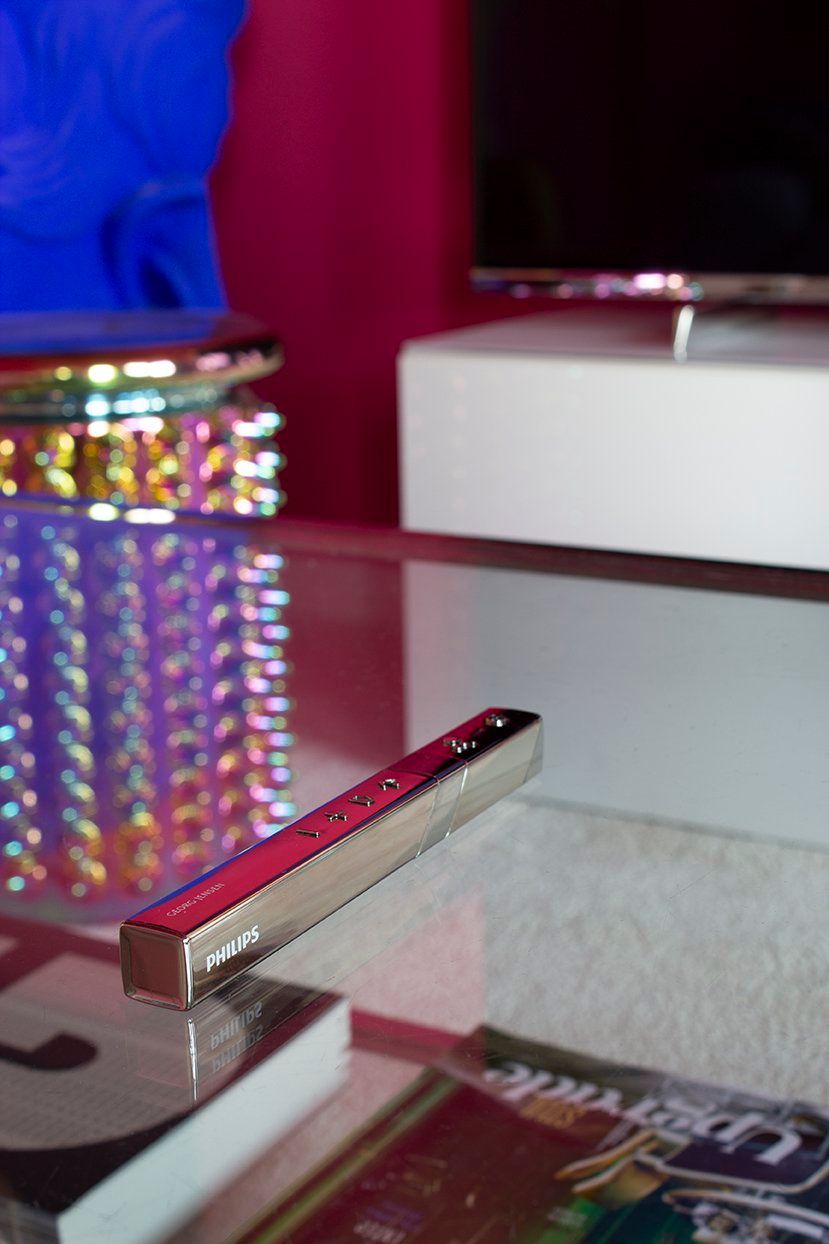TV in your living room? How to make it work with Philips and Georg Jensen
I’m going to be brutally honest with you. And I just know you are going to agree with me one hundred per cent. I hate having a TV in my living room. There, I’ve said it. It’s big, it’s black, a rectangular vortex that demands your attention no matter if it’s…

I’m going to be brutally honest with you. And I just know you are going to agree with me one hundred per cent. I hate having a TV in my living room. There, I’ve said it. It’s big, it’s black, a rectangular vortex that demands your attention no matter if it’s on or off. This is exactly why I banned all 52 inches of my old TV to the bedroom when I redecorated my living room a little over two years ago. I wish I could say ‘and I never looked back’. But if I did, I’d be lying. Because I did look back and now here I am sitting on my sofa, staring at the Philips Georg Jensen TV that arrived a while ago.

Yes, my living room is basically a pink box. How on earth would a big TV actually look good in it? Step one: get art that is even BIGGER. This Wool Island by The Soft World is a nice way to start – and it’s so tactile!
Don’t get me wrong, though. It’s not as if I am one of those apes from the opening sequence of 2001: A Space Odyssey screaming in bewilderment at this shiny black object that had suddenly appeared in their habitat. I’d like to think that I’m a bit more advanced because I gave this a lot of thought. You see, not having a TV in your living room has many advantages. For one thing, you can arrange your furniture in such a way that everyone faces each other. You have a free wall that you can use to put up some art and use that as a conversation starter whenever you have people over. That’s what I did at home and it worked like a charm. And let me ask you this: when you open an interior design magazine, how many times do you actually see a TV in all those picture-perfect homes? Let me tell you how many times: Zero. Which is weird when you think of it. I mean, who doesn’t want to unwind with a little Netflix after a long, hard day at the office? I know I do, and there’s no shame in that. The thing is, though, with my previous TV banned to my bedroom, I actually had to go to bed whenever I felt like watching something. And although I must admit I never minded watching TV in bed, it just didn’t feel right (or maybe a little too right) if I wanted to do so with a nice glass of Sauvignon Blanc.
It was time to face up to the facts. My brilliant plan not to have a TV in the living room had failed miserably. It just had to come back. When I told my friends about my plan, some of them suggested I get one of those TV’s that looks like a framed photo. But I just wasn’t feeling it. Although the concept seemed cool at first, I soon realized it isn’t as practical as you’d think. You see, as an interior design writer who knows a thing or two about art, I always hang paintings a lot higher than I would a TV. It would make very little sense to sit on the sofa and stare at a work of art on eye-level height. But then again, hanging a TV as high as you would a painting wouldn’t be practical either. You’d have a sore neck in a matter of days! What I needed instead, I realized, was a TV that would just look really, really good. A TV that would stand out, but not so much that it would distract from the rest of my living room. Over the last few months, I did some research but only found a handful of models that were acceptable. It wasn’t until I read the press release for the Philips Georg Jensen PUS9104 that I finally had my long-awaited Aha-Erlebnis. With its highly polished steel base and elegant feet, it seemed like the epitome of European design. This was a TV I definitely wanted in my living room. Oh and by the way, if you want to find out the story behind the 9104, I suggest you read the interview I recently did with Rod White, the head of the design team behind it. However, don’t leave just yet, because I have a lot more to tell you here.

A night at the opera – from the comfort of my living room! Notice how art can make a big TV actually look smaller. And what about that Ambilight?
Unboxing a new TV for the first time in fourteen years was nothing short of exciting for someone who frankly used to be a little obsessed with all things TV. I used to be one of those people who would religiously study a TV guide and then use a fluorescent yellow marker to highlight the shows he wanted to watch. Sounds pathetic? It does, I know. But I guess a nerd’s gotta do what a nerd’s gotta do. Besides, if you wanted to keep up with your shows and venture outside from time to time, you needed a VCR – or even two if you wanted to tape more than one show at a time. I used to have a humongous collection of VHS tapes. Complete seasons of It’s Garry Shandling’s Show, The Golden Girls and Seinfeld, an impressive collection of Hollywood musicals and all three Star Wars movies – all painstakingly catalogued with a thick stack of index cards that I kept in alphabetic order in a little transparent plastic box. Even when I’m travelling, I love to watch TV. Staying at a hotel in a foreign country? Let me turn the TV on before I do anything else to see how many obscure local channels I can find. When I was driving through Morocco last year, I stumbled on something called Al Aqsa TV and was so enthralled by an Eighties Arab variety show that I asked all my Muslim friends to identify its most glamorous singer (her name turned out to be Sherihan. Thank you again for solving this particularly vexing mystery, Hicham).

The feet of the Philips Georg Jensen PUS9104 look stunning – you can even keep them as paperweights once the TV stops working many, many years from now.
Installing the Philips Georg Jensen TV was not as hard as I thought. Now normally, I’m a huge optimist – in fact, I’m known to be a bit of a risktaker – but even I was terrified I was either going to drop it, scratch it, break it, or heaven forbid, all of the above. The two feet the Philips 9104 stands on, are design objects in their own right. You can even keep them and use them as paperweights once the TV stops working many, many years from now. It’s a nice thought that helps us cope with the guilt some of us might feel from buying a new product, right? Call me a Gutmensch, I don’t mind. After the long, hot summer of 2018, I even developed one of the first known cases in The Netherlands of flight shame and that is perfectly fine. My resolution never to fly again does make me feel a bit nostalgic for all the trips I used to take, however. This, I guess, explains that one of the first videos I watched on my new TV was of someone wandering the neon-lit streets of Kowloon, Hong Kong with a 4K camera. The city looked even bigger and brighter than I had remembered it from when I was there myself a few years ago – an unreal experience that was even made more unreal in ultrahigh definition. Watching something in 4K from the comfort of your own home is a huge luxury, even now that the Philips 9104 has been in my living room for a few weeks. I upgraded my Netflix plan to 4K, which set me back a few more euros a month. I guess it’s a small price to pay to watch Pose in all its glory. And GLOW. Oh, and Russian Doll. I also briefly considered changing my subscription to Curiosity Stream to 4K, although I have to admit that even regular HD content looks magnificent on my new TV. Without getting too technical, I understand that the software of the Philips Georg Jensen TV lifts up everything to something that looks 4K. Very nice!

It definitely took some getting used to talking to a remote control that looks like a magic wand – but now, I can’t live without it.
I even started binge-watching, which I assure is something I never, ever do. First, I travelled from Venice to China over The Silk Road. For 15 glorious episodes, I fantasized about doing so in real life until I watched The Story of Europe with Historian Dr. Christopher Clark and figured there’s just too much to discover right here in the EU. Speaking of which, I’ve developed a new appreciation for European cinema, of which there is plenty to watch on demand if you know where to look. The CineTree app in particular is a revelation. It has a very limited number of films to choose from, which is a good thing if you’re like me and can spend hours searching for something to watch on demand and then actually end up watching nothing at all. In an effort to brush up my French, I’ve watched Visages, Villages not once, but twice and have now moved onto Rock ‘n Roll, a film about the ravages of midlife crisis that I could relate to more than I’m willing to admit. The CineTree app is not available on AndroidTV, but since the Philips Georg Jensen has built-in Chromecast, streaming a film was as easy as pie. My biggest and most spectacular discovery to date, however, is the Met Opera on Demand. That’s right, I am now officially into opera. It’s big, it’s colorful and again, it’s European. What’s not to like? I’ve been meaning to get a subscription ever since I saw a Met Opera performance of Madama Butterfly at my local cinema and almost walked out because the sound was so loud, everyone was covering their ears well before Un bel dì vedremo even began. It’s a bit of an open door but watching an opera at home is a lot more comfortable. You can take a break to pour yourself another glass of wine, rewind a few minutes if you’ve lost track of the story and play it as loudly or softly as you want. Before I started watching Turandot, I connected my Hue spots to the Ambilight of my TV, thinking it might be a bit of a gimmick at first. But let me tell you, it wasn’t. In fact, watching an opera with all the lights in your living room subtly changing was a mind-blowing experience that only Philips can provide.

Not your average interior design photos, I admit. They do show, however, how Ambilight + Hue can make a beautiful performance into an unparalleled TV experience.
As overwhelming as watching opera on the Philips 9104 can be, I want my TV to blend in as much as possible whenever it’s off. And I’m sure you do as well. There are some easy interior design tips and tricks that can help you reach your goal. First, you have to decide where to put your TV. If you have a living room that is big enough, then I suggest you create a separate TV corner. That way, it doesn’t dominate the room so much – problem solved. The only thing you need to make sure of, is that you place your TV at eye-level. If you’re like me, however, and live in a relatively small place, you have to put in more of an effort. First, paint out the wall behind the TV in a darker color than you would normally use for your living room. You don’t have to go for fuchsia pink the way I did. A nice bottle green, petrol blue or terracotta will do the trick just as nicely. Whatever color you choose, though, never go for white. The contrast between a white wall and the black screen of a television can be awfully harsh – and that is something you want to avoid at all costs. Don’t worry about the Ambilight, you can adapt it to your wall color in your TV’s settings. Another way to let your TV blend in more, is to use art. When I interviewed Rod White, the head of the team that designed my TV, he advised me against using too much clutter. In my book, however, art does not count as clutter so I’d suggest you just go for it. In fact, I’d even say: the bigger, the better. Paintings that are bigger than your TV will actually make it look smaller and less overbearing. Don’t want to break the bank? Go to your local art library if you live in a city that has one. If you don’t, I’m sure there’s an affordable art fair where you can buy one or more paintings that fit your budget. You can even find great pieces at an art academy graduation show. Also, if you buy more than one piece, make sure that they fit together. Either the colors, shapes, patterns or materials should match. If you’re feeling really adventurous, I guess you could go for contrasting elements. Don’t overdo it, however. The last thing you want when you’re watching TV, is to get distracted by the art that’s hanging around it. This is also why abstract paintings tend to work better than figurative works. For my own living room, I used two abstract paintings that have similar shapes in them. One of them matches the pink of my wall, the other one matches the blue of the giant Yves Klein blue head I already had. I also borrowed a black and green light object from my art library. It not only looks stunning, but it also adds a second black element to my TV wall. Pretty clever, if I say so myself. And then, last but not least, I finally came around to having a vintage Hello, Dolly poster framed that I bought on eBay ages ago. Both the poster and the light object feature a circle – another example of matching shapes. Now, you would think that having four works of art on one wall would be a bit much, but take it from me: they’re perfect if you want to prevent your TV from taking over the entire room. In fact, I even added a fifth element: a Wool Island from The Soft World. Unlike the TV, it’s very tactile and I love touching it whenever I walk past it. In fact, the original plan was to hang the Wool Island right next to the TV. I might do so later on, but for now, I’m happy with where it is hanging.
Looking back, I have to say I’m really happy to have a TV in my living room again – especially one that is as beautiful as the Philips Georg Jensen 9104. I watch TV a lot more than I used to, but because there are so many great options to choose from with Android and the built-in Chromecast, I never feel guilty for doing so. I’m also glad I planned ahead and made sure the TV was part of the interior design of my living room, instead of becoming its main focal point. Now if you’ll excuse me, I have some more opera to watch!
